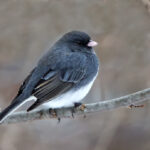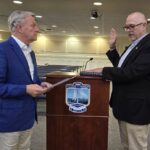WILDWOOD — It’s 6 a.m. on a wintry Tuesday; morning light glances over the empty Wildwoods boardwalk, past the Giant Wheel and The Sea Serpent, the oldest boomerang coaster in the United States, the launching mechanism of which puts riders face-to-face with the Atlantic Ocean.
It might seem like nobody is here, but the maintenance team at Morey’s Piers shows up nearly every day of the year to keep away the frightful byproducts of the salt air: rust and rot, both deadly to coasters that launch guests at highway speeds.
Morey’s Piers is home to three roller coasters famous among online coaster enthusiasts, many of whom visit from across the country to go for a spin. There’s a reason for this: A special level of care is given to the three flagship coasters, one on each of Morey’s three piers, that similarly designed coasters across the country do not receive.


The Sea Serpent is the oldest boomerang in the country, but you wouldn’t know it by looking at it. The fresh white “boomerang”-style coaster was designed by Vekoma, a Dutch coaster designer, in 1984 and was launched at four locations worldwide that year, including at Morey’s Piers in Wildwood. It takes guests twice along its 935-foot track, once forward and once backward — hence, boomerang — at 47 miles per hour.
The Great Nor’Easter is a “suspending looping coaster” (SLC) also designed by Vekoma; it opened in 1995. It’s considered by many to be the best SLC in the world, free from the neck-wrenching turns that plague other coasters of its type. Special care has been given to this coaster; more on that later. Check any coaster enthusiast forum – or ride most SLCs across the country – and you’ll quickly find that they ride rough because the tracking is not always manufactured to the tightest specifications. It takes guests, legs dangling, along its 2,170-foot track at a top speed of 55 miles per hour.
The Great White, opened in 1996, is a wooden roller coaster built by Custom Coasters International. It is perhaps the best-known of the park’s coasters because of its striking presence on the beach’s skyline. It is visible from anywhere south of it on the beach, even in faraway Diamond Beach at the southern end of the island. The coaster’s 3,300-foot wooden track takes guests down a 100-foot drop and hits speeds of 50 miles per hour.
Lots of Upkeep
Will Morey, a third-generation Morey and the operations manager for their water parks, told Do the Shore that the expenses associated with fighting rust and corrosion cost the park a full 1% of its annual revenue. “The rust and corrosion speeds up the replacement cycle – we’re replacing things faster than we otherwise would have to. It’s incredibly difficult to keep up,” he said.
But keep up they do. Nearly every piece of metal – down to the tiniest screw – at Morey’s Piers is galvanized, which means iron or steel pieces are coated with a protective zinc layer that protects from rust.
The maintenance and repair of each coaster is slightly different, but general principles apply across the board. Morey’s keeps a master plan for every ride on its property that outlines daily, weekly and yearly maintenance procedures. Because of the salt air, these schedules are without exception more aggressive than the manufacturer’s recommendations.
“This is probably one of the worst places in the world maintenance-wise to open a theme park,” Morey said.

Every ride vehicle is completely disassembled at minimum once a year to ensure that it is operating within the manufacturer’s tolerance recommendations. Most manufacturers provide a range of operating tolerances, with optimal specs on one end and “good enough” on the other. Morey’s is not tolerant of “good enough.”
Morey said that Vekoma, the Dutch coaster designer that created two of Morey’s biggest coasters, was so impressed by Morey’s Piers’ operation and maintenance schedule that Vekoma at one time sent their staff to the piers to train.
“Our relationship with Vekoma is so good that they sent their field engineers out here for a summer so they could train their employees on our rides,” he said.
Morey’s has an entire pier, not visible by guests, dedicated to the upkeep of their rides. Within this massive pier is a building called the coaster shop, where boxes of coaster parts are stored, and where coaster ride vehicles await TLC.

Ray Sippel, supervisor of training and development at Morey’s and an amusement park veteran with a career at parks across the country, said, “Every year all our trains get torn down to the smallest parts. Everything is cleaned, we measure parts to a thousandth of a millimeter, depending on the manufacturer’s outline.”
Here, bore gauges and micrometers measure the tolerances of pins, shafts and bores on each ride vehicle. The tighter the spec, the smoother the ride. Some of the coaster vehicles undergo mag particle testing, where a magnetic field attracts fine iron filings (think a fine glitter) to cracks and imperfections on the ride vehicle. On the Great Nor’Easter, for example, mag particle testing is done on the axles, seat assemblies and main beams of the ride vehicle.
Dye penetrant inspection is also common here — a maintenance team puts dye on the ride components, wipes off the excess and puts a developer on the part. If there’s a crack, the dye wicks and bleeds out of the part. An ultraviolet light helps identify where these micro-abrasions are occurring.
In the summertime, when the ride vehicles are thrashing down coaster tracks, the coaster shop turns into storage for the giant plushes given away as prizes at Morey’s Piers’ arcade and carnival games.
The Great White

Morey said that the Great White is the most maintenance-heavy ride in their arsenal. Morey’s employs a full-time staff of carpenters who fabricate wooden beams for the coaster on-site. These carpenters also design nearly every wooden fixture at the park, down to the stands where ride operators stand.
A team of two maintenance staffers walks the entire length of the Great White every morning during days of operation to look for things like soft wood or an out-of-place nail. The whole process takes three to four hours. They carry 35-pound backpacks full of tools, mallets and bolts the size of a small man’s forearm. They wear harnesses that would catch them in case of a fall. They do all of this 100 feet above the sands of the Wildwood beach, the widest beach in New Jersey. They must have quite a view.

The manufacturer that created The Great White is now defunct, but Morey said he and his team work with engineers and employees who once worked at Custom Coasters International to keep The Great White in tip-top shape.
The Great Nor’Easter

This coaster went through a complete retrack and repaint in 2017, the first and only time such an extensive overhaul was done on a suspended looping coaster. The retracking was done hand-in-hand with Vekoma, Sippel said.

The retracking was done to the joy of coaster hobbyists. Megan Longergan, marketing coordinator at Morey’s, said that the park holds an annual meet-up for “coasterheads” and that each year she is told that their suspended looping coaster is the best in the country, if not the world.
Sometimes that comes down to fine-tuning the wheels so the trains navigate the track smoother. “There’s a tolerance the wheels can be adjusted into,” Sippel said. “The looser the wheels, the rougher it is. We ignore the wide window of maintenance tolerances and tune it as precisely as we can within the tolerance. We replace the wheels every other year — we replace them all on every train, one train on odd years and the other on even years. Some theme parks might do this once every five years.”
He said that they would not be happy with a coaster that riders might call “rough.”
“One of our approaches is, we have always tried to make it smoother when other parks might say, ‘Oh, it’s an older design, that’s the way it is.’ But we asked ourselves, what can we do to make it better and to stand above the rest?”
But perfect wheels would be meaningless if the track were still rough. Sippel explained that technology has come a long way since the track was originally built. When Morey’s approached Vekoma about a retracking in 2016, they knew modern technology would be on their side, he said.
“Today, we have more digital measurements, we can better 3D model the track now to make the track more accurate in real life compared to what was on the print.”
The Sea Serpent

An opening-day full-page advertisement for the Sea Serpent warned prospective visitors: “Sooner or later, you’ll get enough guts to ride.” Even today, Morey’s holds the Sea Serpent up as one of its best attractions. Like the Nor’Easter, online communities hail this boomerang coaster as one of the best of its kind in the world. It never went through a dramatic reworking like the Nor’Easter did, but special attention is paid each year to every nut and bolt on the ride.
The old sign for the Serpent stands tall in the coaster maintenance shop, with a mighty snake graphic resembling that full-page ad. Thanks to a lot of work from the Morey’s team, the “only boomerang coaster in North America” might now read “the best boomerang coaster in North America.”
The Canceled Coaster

When asked for their burning questions about the coasters, many folks wanted to know about a canceled wooden coaster that would travel between piers, across a bridge and under the boardwalk. This coaster, called the “GCI Coaster” by enthusiasts, was ultimately canceled, but little was said about the reasons why.
Morey said: “It was too expensive to build, and too expensive to maintain.” He explained that the coaster would have been the most maintenance-heavy of any ride on their property, eclipsing even The Great White. A variety of factors played a part in the coaster’s eventual cancellation, but cost was a big one.
“We would have had to hire four full-time carpenters just for maintenance on this ride,” he said.
Morey said that the idea for the coaster came from his uncle, Jack Morey. At one time in the park’s history, Jack Morey wanted to build a new coaster every year for 10 years. “But then COVID happened,” Morey said.
And there was too much else to do, like the water pumps and piping that power the waterpark on Mariner’s Pier. Projects like that cost millions of dollars and aren’t as flashy as a new coaster.
But they are necessary, and the huge amount spent on maintenance is part of what gives Morey’s such a stellar reputation among enthusiasts.
Reach the author, Collin Hall, at chall@cmcherald.com, or give him a call at 609-886-8600 ext. 156








